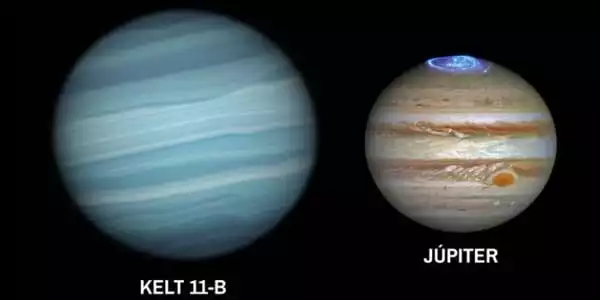KELT-11b is an exoplanet that orbits the yellow subgiant star KELT-11 (HD 93396) about 320 light-years away from Earth. It is a gas giant exoplanet that circles a G-type star. Because of its near orbital distance with its parent star, it is an inflated planet, one of the “puffiest planets” known. It has a mass of 0.171 Jupiters, takes 4.7 days to complete one orbit of its star, and is 0.06229 AU away from it. It has a radius 1.37 times that of Jupiter but just 19% of its mass. It was discovered in 2016.
KELT-11b is an extreme variant of a gas planet, similar to Jupiter or Saturn in the Solar System, but it orbits very near to its host star in an orbit that lasts less than 5 days. This planet is extremely inflated, so while it is only a sixth the mass of Jupiter, it is about 40% larger, making it approximately as dense as Styrofoam.
In 2020, a transmission spectrum investigation found that the KELT-11b atmosphere included sub-solar levels of water vapor, but considerable amounts of hydrogen cyanide, as well as titanium and aluminum oxides. Furthermore, the nightside flux indicates a cloud-free atmosphere with good heat redistribution between day and night. Later research revealed that the spectrum signatures of hydrogen cyanide are not easily separated from those of carbon dioxide and carbon monoxide, despite the fact that carbon dioxide appears to be present in greater quantities, indicating that the planet has a high carbon/oxygen ratio.

The star KELT-11 is approximately 324.3 light-years (99.4 pc) from our Solar System. It has a visible magnitude of 8.0 and an absolute magnitude of 3.0. It is 1.4 times more massive and 2.7 times larger than our Sun. The surface temperature is 5370 degrees Celsius, with G8 spectral types.
The planet’s host star, KELT-11, is extraordinarily bright, allowing precise measurements of the planet’s atmosphere properties and making it a “great testbed for analyzing the atmospheres of other worlds.” The host star, also known as HD 93396, has begun to deplete its nuclear fuel and is growing into a red giant, implying that the planet will be devoured by the star and will not survive the next hundred million years.
KELT-11b was discovered by the Kilodegree Extremely Little Telescope (KELT) survey and is documented in a research published in the Astronomical Journal. The planet is the third-lowest density exoplanet identified with accurately calculated mass and radius.
KELT-11b is one of the most inflated planets known, with an unusually enormous atmospheric scale height (1,717 miles or 2,763 km) and a corresponding size of the predicted atmospheric transmission signal of 5.6 percent.
















